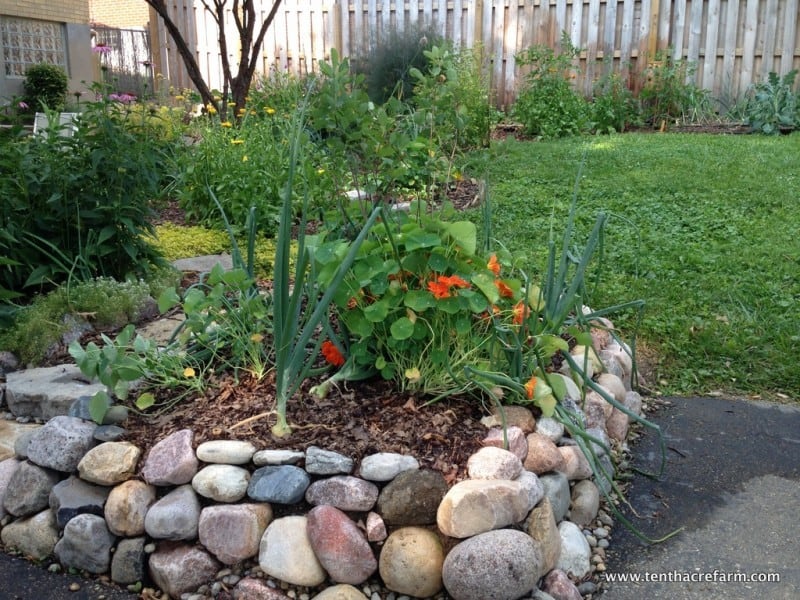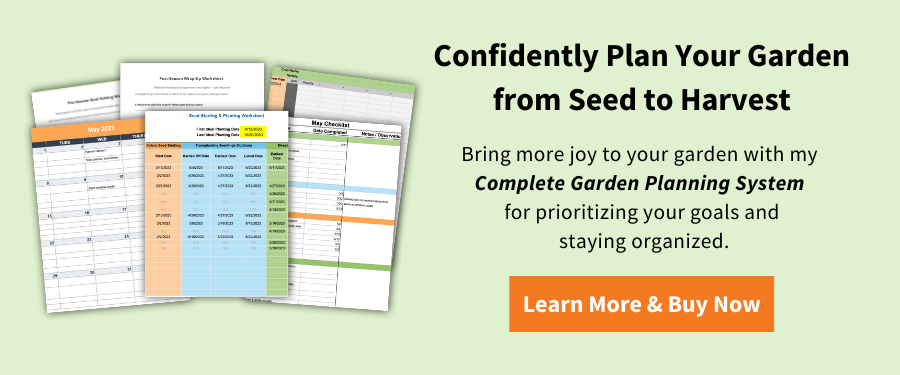How to Start a Garden on a Budget
The materials you need to start a garden can add up in cost. Here are six ideas for starting a garden on a budget without breaking the bank.


This page may contain affiliate links. Please read my disclosure for more info.
Gardening can seem overwhelming when you consider all of the materials you need to get started. Seeds, fencing, soil, tools, and more can add up—even on a generous budget.
Unfortunately, we can’t sprinkle magic fairy dust and have everything we need to instantly start a garden. 🙁
Gardening for the Budget-Conscious
Reader Question: Have you kept track of how much money you spend on your garden supplies, from seeds to fencing, to gravel and tools? I am feeling a little overwhelmed with all of the supplies I need to purchase to work on my yard.
Amen to the overwhelm!
Overwhelm is a common feeling when starting any new hobby or lifestyle. Take that daily yoga routine I’ve been wanting to start, or learning to play the ukulele. It just seems too much to take on if I also add a budget restriction. It makes me want to throw in the towel before I’ve started!
See, sometimes we let feelings of overwhelm talk us into procrastinating because the problem just seems too big to overcome. But let’s see if we can find some small, actionable steps that help us move forward with our garden plans (before procrastination sets in) even if we are cash-strapped.
Speaking of overwhelm, I wrote more on that topic in my article 7 ways to start a new homestead. It highlights more things you can do while saving money for your big garden dreams.
Here are six ways you can start a garden on a budget.


Garden on a Budget – Action 1: Start Slow
Gardening can be quite expensive in the early years when you’re setting up the infrastructure of the garden.
It would be easy to spend upwards of $1,000 a year* buying many of the necessary supplies and equipment! However, it would be very difficult to grow $1,000 worth of food in those first few years.
That’s not a glowing endorsement for breaking the bank and rushing into things!
The return on investment of vegetable gardening tends to be gradual. You’ll grow more produce each year as you hone your skills and become accustomed to the conditions of your little slice of heaven (soil, sun, water, climate, etc.).
Ultimately, it can work in your favor to garden on a budget. It means you don’t have to break the bank to get started!
Start small, and the money you spend on development can be gradual to match the gradually increasing return. Expect your first year to be the starting point that it is. There’s no where to go but up!
In other words, Patience you must have, my young padawan. 🙂
*$1,000 is a random number I made up. Someone who is building a shed, raising chickens, and putting up fences might spend more than that, while someone building a single raised bed in their backyard may spend less than that.
Either way, you can expect your garden development to cost more than you think it should and more than you wish it did.
Grow a garden that’s both productive and manageable with my Complete Garden Planning System, which includes practical tools for planning your season from seed to harvest.
Garden on a Budget – Action 2: Observe More, Do Less
One benefit of starting slow is that you’ll get to observe the gradual changes of your garden over time.
As I developed my previous permaculture edible landscape over the course of eight years (complete with berry bushes, fruit trees, rain gardens, raised beds on the driveway, a composting system, and more), one thing I said over and over is how thankful I was to have a restricted budget.
Because I didn’t have the resources to develop the entire landscape in the first year, I did it bit by bit, year by year.
And you know what happened?
Every time I developed one little bit and observed how it worked within the larger system, I discovered something I hadn’t thought of, and that discovery changed and improved the next little garden project (saving me time and money).
This happened through trial and error, and at the end of eight years, I had developed something that I hadn’t envisioned in the first year. The resulting landscape was prettier, more functional, and more robust than I had originally imagined; all because I took it slow and observed along the way.


Garden on a Budget – Action 3: Save on Raised Beds
Read more about raised beds:
Save on Building Materials
On my new homestead I want to build raised beds, but the price tag on rot-resistant lumber, such as cedar or redwood, is a nightmare! However, since these types of wood are ideal for longevity and keeping contaminants out of the garden, the price may be worth it.
If you decide raised beds are in your future, you can still garden on a budget while you save for those expensive materials.
Try adding compost to the existing soil and gardening there. You may find it works wonderfully, and that raised beds aren’t actually necessary. But if not, consider it practice!
Here are some budget-friendly, raised-bed materials:
- Cinderblocks
- Galvanized stock tanks
- Logs
- Pallets (see picture below)
- Rocks


Pallet raised beds
Here’s how to tell if pallets are safe for gardening projects.
Save on Raised Bed Soil
This is a biggie! Raised beds take A LOT of soil. Importing bulk soil can be expensive, as well as potentially toxic for edible gardens. Unfortunately, bulk compost soil can be contaminated with herbicides, which may damage crops and poison soil for years.
I now aim to make most of my own soil so I know what I’m getting, starting with building a composting system. This means some delayed gratification on my part. There are a few things I need to do to keep herbicides out of my own compost soil, even though I don’t use herbicides in my own yard.
Building your own soil saves money, but you’ll have to wait a year while it makes itself (Still, it’s so cool that it makes itself!).
Some DIY approaches to building soil include starting worm bins for composting kitchen scraps, shredding and composting leaves (pick up curbside leaf bags in the fall/winter), yard waste (from your own no-spray yard), and free wood chips (contact local tree trimmers or Chip Drop).
These composted materials add soil structure, bulk, minerals, and micronutrients.
It may take longer to build your beds, but they’ll be healthier without breaking the bank. And it’s better than importing contaminated soil that could take years to restore.
With a little delayed gratification, you’ll be ahead of the curve.


Spreading homemade compost on spring garden beds.
Would you like more pointers for starting your garden on a budget?
You’ll find more of my tips, tools, and life hacks (including the 15-minutes-a-day garden) in my award-winning book, The Suburban Micro-Farm.
Garden on a Budget – Action 4: Choose the Right Tools
When I first started gardening, I didn’t have any tools for digging or building a landscape. So I started out with the cheapest tools I could find. Some of them came from my parents’ garage that they no longer used. Others I found at garage sales and discount stores.
If I wasn’t starting a garden on a budget in my first year, I would have gone out and bought a bunch of tools I thought I needed. But they wouldn’t have been the tools I actually needed!
To find out what tools I actually needed, I needed to get started, get my hands dirty, and discover what I needed.
This is a round-about way of saying that if you have to start out with cheap or poor-functioning tools, you’re actually in a good place. Weird, I know!
You’ll quickly discover which tools would make your life better because they’ll be the ones you always reach for. You’ll groan with frustration because they’ll be the ones that break, give you blisters, or make you work twice as hard.
Through this process of just getting started, I discovered which tools were going to give me a good return on investment, and I purchased good quality versions of them as the cheap ones broke or as I found money in the budget.
If you’re considered to be on a low income, there may even be some non-profits or other local assistance to help you access the tools you need. If you live in a neighborhood association, you may be able to borrow tools from a community toolbank, which lends tools to non-profit organizations.
A good gardener—regardless of budget—is resourceful. It makes good sense to start out with what you can hunt down, and add the things you truly need later.
My top five favorite tools for my no-till garden are:
- Felco Pruning Shears (for cutting woody plant matter)
- Hori Hori Garden Knife
- Heavy Duty Digging Fork
- Stainless Steel Garden Shears (for cutting green plant matter)
- Winter Garden Gloves
I purchased these nicer versions as soon as I could, somewhere between my second to fourth gardening years. I’m sure I whined about it until I convinced Mr. TAF that they needed to be in the budget! 🙂
But you know what? I appreciate them immensely because I planned ahead, chose the right tools, and budgeted for them.


Build your own soil to save money and know what you’re getting.
Garden on a Budget – Action 5: Forage for Other Awesome Materials
Things like garden borders and pathways can be made up of whatever you have on hand, especially if you’re starting your garden on a budget.
For a DIY border that keeps kids and dogs out of the garden, try collected rocks or wine bottles. If you don’t personally enjoy wine, simply ask at your nearest bar or restaurant; I’m sure they’d save some for you!
I enjoy lining beds and pathways with split firewood that is past its prime.
Ask your friends and family for possible useful items. Remember, their junk could become your treasure, and everybody wins! Craigslist and Freecycle are great places to check, too.
Garden on a Budget – Action 6: Become your own Seed/Plant Vendor
Learning a few skills is a great money-saver when you want to garden on a budget. You might seek out free local classes or find more information online.
Starting your own seeds can save money that you would normally spend on purchasing seedlings. If you have a greenhouse or cold frame, you’re way ahead of the curve.
Starting your own seeds indoors under lights saves money in the long run. However, this solution requires you to purchase a lot of equipment up front, so I don’t recommend it until you have a few years under your belt and can invest in this extra equipment.
Saving your own seeds is a really rewarding experience. How amazing would it be to start off spring planting with your own seeds that you saved from your own plants? This is a worthwhile skill to learn that doesn’t cost you a thing!
Here are a few resources about seed saving:
Grafting is a technique for creating fruit trees, among other plants, that meet specific needs. It works by attaching the tissue of one plant to the tissue of another.
For example, if one variety of apple is known for its strong roots, and another variety is known for its disease-resistant fruit, tissues of the two can be attached together to create a hybrid variety that is more robust.
This skill can help you to produce a whole lotta fruit trees for a very low cost! Here’s a great tutorial on grafting.
You can also propagate many fruit crops for free by taking cuttings from existing plants. Your friends and neighbors will likely be happy to donate cuttings.


Homegrown and saved coriander (cilantro) seeds
The Hard Truth About Gardening on a Budget
The beginning years of developing a garden or edible landscape certainly cost more both financially and in terms of sweat equity. This is understandably overwhelming to think about, but remember that small, actionable steps are what will move you forward.
At the end of eight years at my old house, the garden and edible landscape were fairly well established, so I spent less money each year on buying seeds and miscellaneous supplies.
However, the first few years are quite different! I’m reminded of that now that I’m beginning to develop my new homestead. I’ll have to build it in stages as my budget allows.
It’s hard to delay gratification when you’re so excited to start a garden, but you’ll be rewarded for budgeting, planning ahead, and starting small.
In the meantime, observe your landscape through the seasons, creatively source the items you need, and practice gardening even if the situation isn’t ideal. You might also want to consider asking for gardening-related gifts. My Gift Guide for Permaculture Gardeners includes some of my favorite products that make gardening with nature a fun and rewarding experience!
Stay focused on the small actions you can take to move forward, and your dreams will become reality!
What is your tip for starting a garden on a budget? Share it in the comments below!
READ NEXT:









